|
||||||||||||||||||||||||
Cannot see this message? Click here.
|
||||||||||||||||||||||||
Cannot see this message? Click here.
OPENING CEREMONY
Sunday, September 27. By 6:45 pm. Hundreds of people enter the plenary room of the Convention Center “SulAmérica”, in Rio de Janeiro (Brazil) for the opening ceremony of the 14th annual meeting of the Brazil Materials Research Society, whose acronym in Portuguese is SBPMat. The opening table is composed by the chairmen of the event, Prof. Marco Cremona (Brazil) and Prof. Fernando Lázaro Freire Junior (Brazil), as well as the present SBPMat president, Prof. Roberto Mendonça Faria (Brazil), the immediate past president of the European Materials Research Society (E-MRS), Prof. Rodrigo Martins (Portugal), and the general secretary of the International Union of Materials Research Societies (IUMRS), Prof. Robert Chang (USA). Behind them, a big banner shows the logos of dozens of institutions and companies that gave financial support to the event.

Near 1,000 attendants are present at the ceremony, which starts with the Brazilian national anthem. The chair Prof. Cremona welcomes the participants to the meeting. Prof. Robert Chang, who was president of MRS (Materials Research Society) in 1989 and founded IUMRS in 1991, convokes the participants of all countries to try to solve together the most important global challenges for materials research, related to health, food, environment, transport etc. Representing E-MRS, Prof. Martins, who presently takes care of Global Leadership and Service Award at IUMRS, emphasizes his desire of promoting international connections. Prof. Faria talks a little bit about Brazil, which, as well as other developing countries, is very rich in raw materials but needs to add value to its products by means of science and technology.
After the opening, Prof. Eloisa Biasotto Mano (Brazil) goes to the stage for the Memorial Lecture “Joaquim da Costa Ribeiro“, which is a distinction bestowed annually by SBPMat on a Brazilian researcher with outstanding career in the field of Materials. This 91-year-old scientist pursued international scientific education at a time when most women were illiterate in Brazil, and founded in the Federal University of Rio de Janeiro (UFRJ) the first research group in polymers in the country. This group later became the Institute of Macromolecules (IMA), which was directed by Eloisa until she retired. In the memorial lecture, she talks about macromolecular materials and, using a representation of a polyethylene molecule made by herself with wire, she shows how these kind of molecules behave in response to their big size. A group of Prof. Eloisa´s disciples (among them, the present director of IMA) assists her with the presentation, showing affection, gratitude and admiration for her . After the talk, many attendants of diverse ages make a queue to take a picture with this protagonist of the dawn of polymer science in Brazil. Eloisa, who is professor emeritus of UFRJ, poses for all the pictures she is ask to. At the end of the photo session, she accepts our microphone and leaves a message for the young people starting a carreer in science:
Right after the memorial lecture, in the same venue, the participants enjoy the welcome cocktail while meeting friends and collaborators. The cocktail is animated by live “chorinho” music, an instrumental Brazilian popular genre original from Rio de Janeiro.
———————————————————————————————————-
PLENARY LECTURES
Nader Engheta
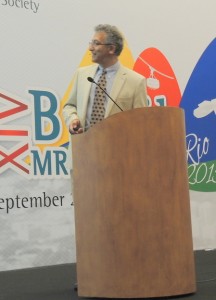
Monday, September 28. At 8:30 in the morning, the plenary room is full of attendants waiting to learn about metamaterials and the extreme behavior of waves interacting with them in the first plenary lecture of the event. The speaker is Nader Engheta, the H. Nedwill Ramsey Professor of Electrical and Systems Engineering at the University of Pennsylvania (United States). This Iranian-born scientist is a recognized world leader in research on metamaterials, and holds an H number of 69. Through experimental and theoretical research, Engheta and his collaborators have created such unconventional things as nanocircuits made of metamaterials that function as optical filters. Since the beginning of the talk, Engheta captivates the audience with some history of science and with a world of structures created by using particular composite metamaterials with particular sizes and geometries and arranged in particular ways with the aim of obtaining unconventional interaction with light and other waves.
————————————————————————————————————————————————————————–
Edgar Zanotto.
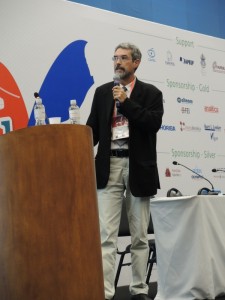
In the afternoon, at 3:30, more than 400 people attend the second plenary lecture, which is about glass-ceramics (materials formed through controlled crystallization of certain glasses). The speaker is the Brazilian researcher Edgar Zanotto, Professor at the Federal University of São Carlos (UFSCar), in Brazil, where he founded and heads the Vitreous Materials Laboratory (LaMaV) that assembles a big international team. Zanotto, who is a world-renowned expert on glass-ceramics, presents in his lecture many useful applications of these materials, such as cooking hobs or artificial bones and teeth. He also mentions the scientists who, along 60 years of glass-ceramics history, contributed to the advancement of research on that topic. In spite of those contributions, the comprehension of some aspects of the formation of glass-ceramics is not complete, he says, but that is not a problem for glass-ceramics fabrication and applications. It´s just an opportunity for fundamental scientists.
————————————————————————————————————————————————————————-
Paul Ducheyne. Biomaterials. Merging Materials Science with Biology.
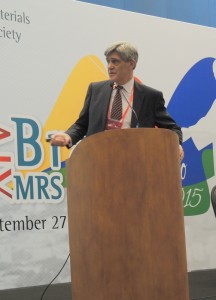
Tuesday, September 29. 8:30 am, time for the third plenary lecture of the event. The lecturer, Prof. Paul Ducheyne, also comes from University of Pennsylvania (USA), where he directs a multidisciplinary center for bioactive materials and tissue engineering research. An authority on biomaterials field, Ducheyne is the editor in chief of a six-volume book on biomaterials published in 2011. In the talk, he shows a series of biomaterial-made devices, grafts, scaffolds etc., most of them already being commercialized, that actively interact with the body, either by promoting tissue formation (for example, bone) or by releasing drugs for diverse treatments. Ducheyne presents their effects on solving health problems, numbers about their markets, and scientific recent advances that can make them even more effective.
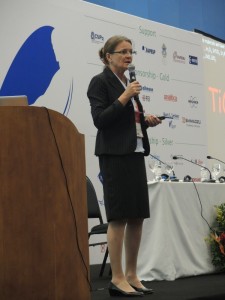
Some hours later, at 3:30 pm, hundreds of participants cluster again, this time around Prof. Ulrike Diebold, whose research group at UT Wien (Austria) is devoted to the understanding of fundamental mechanisms and processes occurring in surfaces at the atomic scale. Prof. Diebold catches the audience attention from the beginning to the end by showing, through scanning tunneling microscopy images, how she spies the behavior of atoms on the surface of metal oxides – topic in which she is a worldwide leader researcher. In particular, she reveals two secrets of metal oxide surfaces: the first one about how oxygen adsorbs on titanium dioxide and the second one about how active single metal atoms are in oxidation process in magnetite.
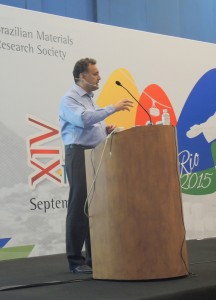
Wednesday, September 30. In the plenary lecture of the morning, the audience is transported again to the social-impacting world of biomaterials by Prof. George Malliaras, Greek-born, working at École Nationale Supérieure des Mines de Saint-Étienne (France), where he heads the Department of Bioelectronics. Malliaras has an H index of 64. After many years working on organic electronics, he entered the new field of organic bioelectronics and obtained impacting results. His research is about electronic devices made of conducting polymers that match properties of living tissues. These devices are used for interfacing with human brain – a “natural electronic device”. The final purpose is to study brain activity or diagnose and even treat neurological diseases such as epilepsy. An example of device is a transistor that enables boosted in vivo recording of brain activity with low invasion. As suggestions for the materials community, Malliaras highlights the importance of collaboration with neuroscientists and physicians and the challenge of improving the understanding of electronic transport and structure.
————————————————————————————————————————————————————————–
Ichiro Takeuchi. Combinatorial Approach to Materials Discovery.
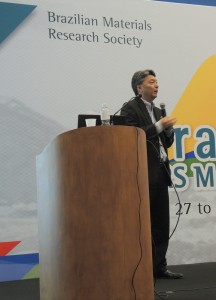
In the talk of the afternoon, the speed of science progress accelerates following the beat of the combinatorial approach. Prof. Ichiro Takeuchi, from University of Maryland (USA), explains how his group manages to optimize materials and properties discovery. As well as in lottery one can buy a big number of tickets to have more chances to win a prize, in materials discovery scientists can produce a huge number of combinations of elements to obtain a compound with desirable properties. For example, for quaternary compounds, millions of combinations are possible, from which only 0,01 % are known. In Prof. Takeuchi´s lab, machines for thin film deposition used with masks work night and day to create patchwork-like samples containing libraries of similar compounds. Then, the libraries are characterized by rapid tools, giving information about the properties of several compounds at the same time. Coupled with appropriate theory and computational simulations, these high-throughput experiments become real materials discovery engines.
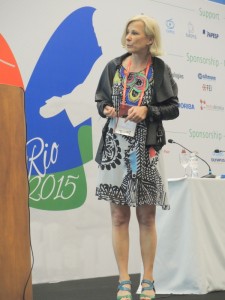
Thursday, October 1st, 8:30 am. In the last plenary lecture of the event, Prof. Claudia Draxl (Humboldt University, Germany) publicly wonders how to make available the huge amount of data resulting from experiments around the world, high-throughput screening, computer clusters etc. Why to do that with scientific data? For confirmation, broad dissemination in society, sharing with distant collaborators and reuse with new purposes. With that aim, Prof. Draxl and collaborators from European countries are facing the development of a repository of materials raw data, called Novel Materials Discovery (NoMaD), which hosts, organizes and shares materials data on the web.
SYMPOSIA SESSIONS
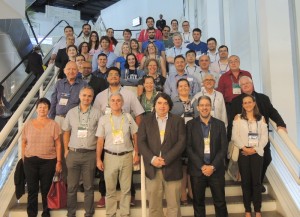
The symposia at SBPMat annual meetings are selected from proposals that can be submitted to the event committee by any scientist from anywhere in the world. This edition of the event encompassed 26 symposia (including the satellite event “8th International Summit on Organic and Hybrid Solar Cells Stability”) and 2 workshops, and it registered symposia coordinators from Argentina, Denmark, England, France, Germany, Italy, Ireland, Japan, Portugal, Spain, Swiss, USA, and, of course, Brazil. Within the symposia, near 190 invited speeches and more than 2,000 technical works are presented and discussed in oral and posters sessions, on a wide range of subjects going from carbon nanostructures to biomaterials, from characterization techniques to computer simulation, from materials for sustainable development to safe use of nanomaterials.
While some symposia have been held year after year in the SBPMat meeting, the University Chapters symposium was a novelty of this year meeting. It was completely organized by students from diverse points of Brazil who are coordinators of the SBPMat University Chapters. The chapters are organized teams, affiliated with the society, composed of graduate and undergraduate students working in materials field. The members of these groups carry out diverse activities that complement their academic education. The students from the existing chapters, which were eight in number up to the moment of the meeting, faced the challenge of organizing a symposium – a task that is usually done by senior researchers.
In fact, students have not only active but also massive participation in the XIV SBPMat meeting. Almost half of the attendants (950 people) were master, doctoral and even undergraduate students doing research on materials field. In Brazil, the federal agency for research support, CNPq, has a program called “scientific initiation” that grants scholarships to undergraduate students to conduct research under the supervision of a Professor.
For the oral sessions of the symposia, all along the meeting, after the morning plenary session, and before and after the afternoon plenary talks, the attendants distributed themselves among 17 rooms. The poster sessions took place at the end of the afternoon from Monday to Wednesday and in the morning on Thursday. Walking through the long corridors of the poster sessions, one could see active scientific discussion, many times between a young author and a renowned researcher. One could also hear very positive comments about the original arrangement of the poster panels. The size of the poster session was impressive. In total, near 1,800 research works were presented in the posters.
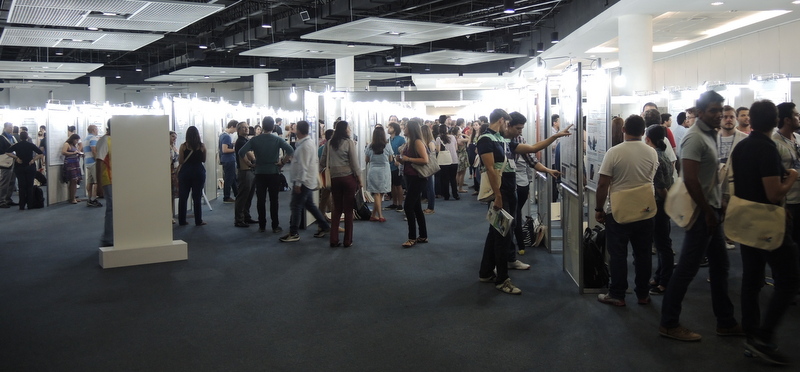
———————————————————————————————————————————————————————————
EXHIBITION
Twice a day from Monday to Wednesday, the attendants could take a break and have a coffee with cookies while visiting the exhibition of the event, which encompassed 32 stands showing a variety of scientific instruments, services, scientific journals, books and opportunities for the materials community. In addition, on Wednesday, the participants had the opportunity to attend four hours of technical talks given by some expositors about fabrication and characterization techniques.
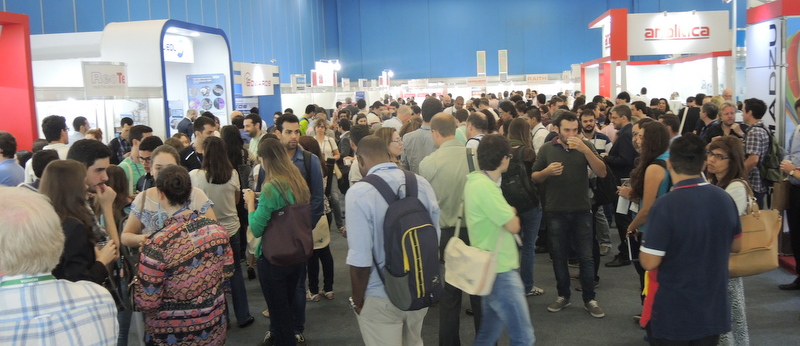
——————————————————————————————————————————————————————————
CLOSING AND AWARDS CEREMONY
On Thursday by 12:30 the closing ceremony started. In the closing panel, Prof. Soo Wohn Lee, from MRS Korea and conference chair of the IUMRS-ICAM 2015, joined the representatives of SBPMat, E-MRS and IUMRS.
In his final remarks, the meeting chair Prof. Cremona presented some photos of the past days and hours that made the public remember so nice and fruitful moments. He also presented the numbers of the event: 2,000 registered people from 985 institutions, among which 300 were foreign researchers from 40 countries. Finally, he announced that the next SBPMat annual meeting will be held in Campinas city (São Paulo state).
After the closing words, more than 20 prizes were given to young researchers within four different awards: the Bernhard Gross Award, a traditional SBPMat recognition for the best works of students, and the awards bestowed by IUMRS, E-MRS and Horiba.

Click on the icon below to go to the web album with our photoreport of the event.
 |
| XIV SBPMat (B-MRS) Meeting – Rio de Janeiro, Sept 27 – Oct 1, 2015 |
|
||||||||||||||||||||||||||||||
|
||||||||||||||||||||||||||||||||||||||||
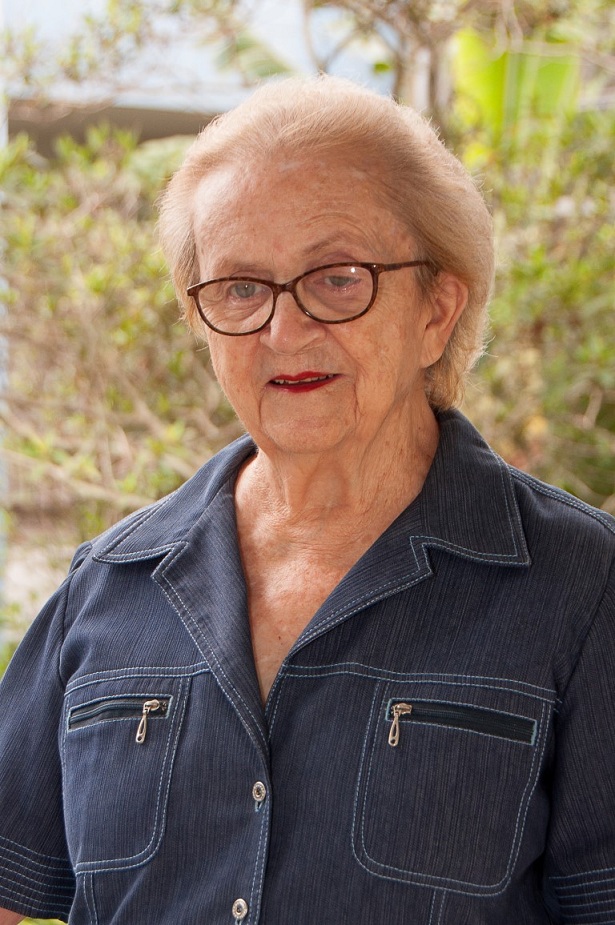 Since 2011, every year, SBPMat (the Brazilian Materials Research Society) has been granting awards to researchers with outstanding work in the field of Materials. Such researchers have the opportunity to make a lecture during the SBPMat annual meeting. The name of the award is Memorial Lecture “Joaquim da Costa Ribeiro”, in honor of Prof. Costa Ribeiro, a pioneer in Materials experimental research in Brazil. In 2015, the SBPMat award will be delivered to Eloisa Biasotto Mano, professor emeritus of the Federal University of Rio de Janeiro (UFRJ), during the opening of the XIV SBPMat Meeting, on September 27 at 19 pm in the SulAmérica Convention Center (Rio de Janeiro). During such event, in addition to receiving the award, Professor Biasotto Mano will speak of the importance of macromolecular materials.
Since 2011, every year, SBPMat (the Brazilian Materials Research Society) has been granting awards to researchers with outstanding work in the field of Materials. Such researchers have the opportunity to make a lecture during the SBPMat annual meeting. The name of the award is Memorial Lecture “Joaquim da Costa Ribeiro”, in honor of Prof. Costa Ribeiro, a pioneer in Materials experimental research in Brazil. In 2015, the SBPMat award will be delivered to Eloisa Biasotto Mano, professor emeritus of the Federal University of Rio de Janeiro (UFRJ), during the opening of the XIV SBPMat Meeting, on September 27 at 19 pm in the SulAmérica Convention Center (Rio de Janeiro). During such event, in addition to receiving the award, Professor Biasotto Mano will speak of the importance of macromolecular materials.
Eloisa Biasotto Mano was born on October 24, 1924 in Rio de Janeiro. By 13 years of age, she did not know what science was, neither did she know what a scientist’s work was about, as these subjects were little present and were inaccessible to the public in Brazil at that time, when there was not even television in the country. However, there were books, and Eloisa had access to many of them in the printing house where her uncle worked as an editor. The girl, who was very serious and responsible, had been assigned to review the proofs of works translated from French. And behold, Eloisa had to read “Madame Curie”, the biography of that scientist woman, born in Poland, who had won two Nobel Prizes, and who had died a few years ago. “I found it great for someone to be so interested in something and have the life she’d had,” recalls Eloisa in an interview in the documentary “Eloisa Mano”. This is how Eloisa discovered the word “chemistry” and began to take an interest in this field of knowledge.
At 20 years of age, Eloisa Mano was admitted into the National School of Chemistry of the University of Brazil (UB), currently UFRJ, to carry out her studies. This occurred in the 1940’s, when less than 40% of women (and less than 50% of men) were literate in the country. Higher education was just beginning; institutions could be counted with the hands´fingers. But Eloisa graduated in Industrial Chemistry in 1947. In 1955 she also obtained the degree of the newly established course of Chemical Engineering. In 1949, she specialized in rubber technology at the National Institute of Technology, also in Rio de Janeiro, one of the few institutions, which, at the time, had infrastructure for experimental research. Given her good performance, she was invited to remain in the institution as a technology chemist, which allowed her to acquire experience in polymer technology.
At that point, Eloisa had higher education degrees, but she felt she could learn more. She thought that there should be a good option abroad and that she could somehow arrange her means to travel, since she could not afford the expenses herself. She then went to the US Embassy and was given great news: there was a scholarship for someone with her profile. Thus, between 1956 and 1957, she was able to study polymer science at the University of Illinois, USA, under the advisory of Professor Carl Shipp Marvel – considered a great scientist and a pioneer in the field of organic chemistry/polymers.
After her experience abroad, Eloisa returned to the National School of Chemistry at UB and worked in Industrial Microbiology for 5 years. In that period, she learned a lot with her mentor, Professor Raymundo Augusto de Castro Moniz de Aragão. Aragão was one of the instigators of the creation of a UB Chemistry Institute, dedicated to research and graduate studies, which happened in 1959. Later, Professor Aragão became the dean of the university and minister of Education and Culture of Brazil.
In 1960, Eloisa Mano obtained her PhD degree from UB with a dissertation in organic chemistry. In 1962, she was admitted into the Chemistry Institute of the UB after a highly competitive selection process, and obtained the chair of organic chemistry. That same year, the Chemistry Institute became one of the first institutions in the country to offer graduate courses and began accepting applications for Masters studies in organic chemistry and biochemistry.
In 1964, Eloisa left Brazil for her second training in polymer science, this time at the University of Birmingham (England), with Professor J.C. Bevington. The following year, Eloisa came back to Brazil and to the university, whose name had changed in 1965 to UFRJ, as it is currently. In 1968, Prof. Eloisa created the first research group in polymers in Brazil, initially composed of 9 master students advised by her, who worked on the UFRJ campus at Praia Vermelha. The Polymer Group gained a good reputation constantly attracting new members, but the physical infrastructure did not grow along with the group.
In 1972, the group managed to obtain financing from government agencies for the construction of a new building at the UFRJ campus at Fundão Island. The group then was named “Macromolecular Center”. Eloisa personally took care of the building’s project, and continued taking great care of her workplace after the building was constructed, in 1978.
In 1976, the center was transformed into the Institute of Macromolecules (IMA), and professor Eloisa became its first director, a position she held until her mandatory retirement in 1994. That year, IMA was renamed to Professor Eloisa Mano Institute of Macromolecules. In 1995 Eloisa was named UFRJ professor emeritus.
Along with her work at IMA, professor Eloisa engaged in international activities that contributed to internationalizing the IMA, generating opportunities abroad for students of the institute. Besides being part of the editorial board of several national and international journals in the field of polymers, Eloisa was a visiting researcher/ professor at universities and research institutes from the Netherlands, Norway and Spain (1972), Germany (1976), Mexico and the United States (1977), Argentina (1978), Japan (1979), Chile (1983), France (1989), among others.
In over half a century dedicated to research, Eloisa Mano advised about 50 masters and doctorate theses, and published 17 books, 4 book chapters and over 200 papers in national and international scientific journals. In these publications, she collaborated with about 250 co-authors.
Her performance was recognized through awards and distinctions by many different entities such as the American Chemical Society (ACS), Society of Plastics Engineers (SPE), Society of Polymer Science, Brazilian Chemical Society (SBQ), Brazilian Association of Chemistry (ABQ), Brazilian Association of Polymers (ABPol), Regional Chemistry Council, Rio de Janeiro Government, Presidency of Brazil and industry federations of Rio de Janeiro.
2,325 works are accepted for oral presentation or poster in the XIV SBPMat Meeting (Rio De Janeiro, September 27th to October 1st). The number is the greatest in the history of the meetings of the society.The amount of submitted works was 2,444.
This year the meeting has 26 thematic symposia, 2 workshops (on nanomanufacturing and organic electronics in the industry) and 1 symposium organized by students who belong to the SBPMat university chapters (UCs).The symposia with more accepted works (more than 200 accepted abstracts) are symposium C, on characterization and applications of nanomateriais, with 272 works, and symposium S, on materials for sustainable development, with 253 works.
Among the accepted works, those submitted by authors who are undergraduate or graduate students will be able to compete for the Bernhard Gross Award, who will distinguish the best works from each symposium (1 oral and 1 poster).To participate of the award, the authors have to submit an extended abstract, according to the instructions and the model that appears in the website of the event, until August 21.
About the event
The SBPMat annual meeting is a traditional, international forum, dedicated to recent advances and perspectives on Materials Science and Technology. In the last editions, the event has gathered approximately 1,500 attendees, from the five regions of Brazil and dozens of others countries, for presenting and discussing scientific and technological studies in the field of Materials. The event also counts with plenary lectures, offered by internationally renowned researchers, and an exhibition of interest for the Materials community.
Advances in understanding brain activity and in the diagnosis and treatment of neurological diseases such as epilepsy and Parkinson’s may arise with the help of Materials Science and Engineering. More precisely, of organic electronics. In fact, organic materials with electronic properties are great interfaces between the signals sent by the brain and the outside, whether to study the brain or to interact with it.
The subject will be addressed in a plenary talk during the XIV SBPMat Meeting, given by Professor George Malliaras, head of the Department of Bioelectronics at the Ecole Nationale Supérieure des Mines de Saint-Étienne, where physicists, material engineers, electronic engineers, biologists and neuroscientists work together.
 Malliaras graduated in Physics in 1991 from Aristotle University (Greece). After that, he entered the doctoral program in Mathematics and Physical Sciences at the University of Groningen, in the Netherlands. His thesis on photorefractivity in polymers earned him a distinction in the university (cum laude). After receiving his Doctoral degree, defended in 1995, he moved away to the United States. For two years, he held a postdoctoral fellowship at the IBM Almaden Research Center, to then become a Professor of the Department of Materials Science and Engineering at Cornell University, in New York. From 2006 to 2009, he worked as head of a national laboratory linked to the university, the Cornell NanoScale Science & Technology Facility. In 2009, he founded the company Orthogonal, which operates in the field of organic electronics. In the same year, he returned to Europe as Professor of the Ecole Nationale Supérieure des Mines de Saint-Étienne, where he remains to this day.
Malliaras graduated in Physics in 1991 from Aristotle University (Greece). After that, he entered the doctoral program in Mathematics and Physical Sciences at the University of Groningen, in the Netherlands. His thesis on photorefractivity in polymers earned him a distinction in the university (cum laude). After receiving his Doctoral degree, defended in 1995, he moved away to the United States. For two years, he held a postdoctoral fellowship at the IBM Almaden Research Center, to then become a Professor of the Department of Materials Science and Engineering at Cornell University, in New York. From 2006 to 2009, he worked as head of a national laboratory linked to the university, the Cornell NanoScale Science & Technology Facility. In 2009, he founded the company Orthogonal, which operates in the field of organic electronics. In the same year, he returned to Europe as Professor of the Ecole Nationale Supérieure des Mines de Saint-Étienne, where he remains to this day.
Malliaras, whose h-index is 64, according to Google Scholar, has authored over 200 scientific papers, with more than 13,000 citations. His work with organic electronics and bioelectronics has received awards from the New York Academy of Sciences, U.S. National Science Foundation and the company DuPont, to name a few entities. He has given over 230 invited lectures and organized several events, for instance, the 2015 MRS Fall Meeting, in which he served as Meeting Chair.
He is a member of scientific boards in research centers in Germany, Ireland and Sweden. He is also an associate editor of Science Advances, an open access, peer-reviewed journal, released this year by the AAAS, which also publishes Science.
In his plenary talk at the XIV SBPMat Meeting, the scientist will address devices based on organic materials with electronic properties, bringing examples and opportunities.
What follows is a mini-interview with this plenary speaker of the XIV SBPMat Meeting.
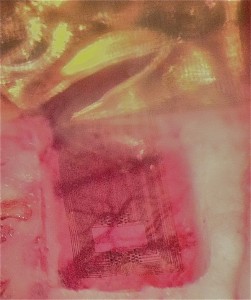
SBPMat newsletter: – In your opinion, what are your most significant contributions in the field of organic electronics/bioelectronics? Please explain them, very briefly, and share references from the resulting articles or books, or comment if these studies have produced patents, products, spin-off companies etc.
George Malliaras: – In the field of organic electronics it would be the co-development, together with Chris Ober at Cornell University, of orthogonal lithography. This is a set of processes that allows the microscale patterning of organic films using photolithography, the golden standard in microelectronics. Orthogonal lithography relies on the use of fluorinated photoresists that do not damage organic films. It allows the microfabrication of devices, including high resolution displays, using standard equipment that already exists in industry. There is a company (Orthogonal, Inc.,www.orthogonalinc.com) that has commercialized the photoresists and is pursuing commercialization of this technology. In bioelectronics, the work is too recent and I would have to wait for the benefit of hindsight. A trend that was emerging when I joined the field involved a transition from the use of organic coatings to the use of organic devices. The latter undoubtedly offer more capabilities to the interface with biology. My group is contributing to this trend by demonstrating that organic electrochemical transistors bring several benefits as transducers of biological phenomena, such as large amplification which enables high quality recordings of brain activity.
References:
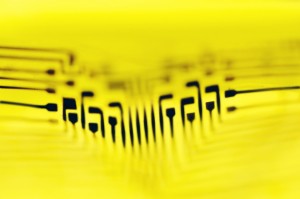
SBPMat newsletter: – Which are, in your opinion, the main challenges for materials scientists and engineers about organic electronics interfacing with the brain?
George Malliaras: – To find the right collaborator who helps them formulate the right questions. I believe that embarking on an interdisciplinary field alone is a recipe for producing low impact work. The key to high impact work in this field is to formulate questions that are interesting to both neuroscientists and to us materials scientists and engineers. From our end, we need to be able to elaborate what are the advantages that organics offer and then figure out how to best employ them to address specific problems neuroscientists face. In my experience, it is often a combination of advantages (mixed conductivity, biocompatibility, “soft” mechanical properties) rather than a single one that gives the advantage to organics.
SBPMat newsletter: – If you wish, leave a message or an invitation to your plenary talk to the readers who will attend the XIV SBPMat Meeting.
George Malliaras: – I often quote a statement by Tadahiro Sekimoto, former president of Nippon Electric Corporation: “those who dominate materials, dominate technology”. It highlights the importance of materials research in our world and shows the dangers of moving to a “service” economy.
More
Prof. George Malliaras´ bio and abstract of his plenary lecture.
They are present in devices used in widely practiced medical procedures with the aim of treating or diagnosing health problems. They become part of the human body, temporarily or permanently, and interact, in a more or less active manner, with the biological system in which they are inserted. Obviously, we are talking about biomaterials. Examples of devices made of biomaterials are quite numerous. We can mention, among many others, stents that release drugs to achieve best results in the opening of arteries that are becoming blocked, and orthopedic implants that promote the regeneration of the bone tissue they are temporarily replacing.
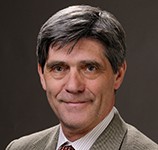 Biomaterials is the subject of the XIV SBPMat Meeting´s plenary lecture that will be given by Paul Ducheyne. In the talk, Ducheyne will address, in particular, two kinds of biomaterials: bioactive ceramics with in situ functionalization, and sol-gel nanoporous materials that delivery drugs and other molecules.
Biomaterials is the subject of the XIV SBPMat Meeting´s plenary lecture that will be given by Paul Ducheyne. In the talk, Ducheyne will address, in particular, two kinds of biomaterials: bioactive ceramics with in situ functionalization, and sol-gel nanoporous materials that delivery drugs and other molecules.
Ducheyne is a Professor of Bioengineering and of Orthopaedic Surgery Research at the University of Pennsylvania (Penn), United States. He is also Director of the Center for Bioactive Materials and Tissue Engineering, a group of multidisciplinary research that brings together scientists from the Engineering, Dentistry and Medicine Departments at Penn. Besides, Ducheyne is a Special Guest Professor at the University of Leuven (KU Leuven), Belgium, where he obtained his MSc and PhD degrees in Materials Science and Engineering.
Paul Ducheyne is the author or editor of a number of books on biomaterials; in particular, he is editor in chief of “Comprehensive Biomaterials,” a 3,650 paged book divided into six volumes, published in 2011 by Elsevier publisher. Owner of a 58 H index, he has published about 330 scientific papers with more than 10,000 citations – of which some 2,600 belong to his 10 most cited articles. Ducheyne has also authored over 40 patents. In addition, from the 1980s on, he has organized several conferences and symposia in biomaterials.
In 1992, Ducheyne founded the company Orthovita, dedicated to products for treating injured bones and for controlling bleeding, and he was its CEO until 1999. In 2011, the company became part of Stryker Corporation, one of the leaders in the market of technology for medicine.
Paul Ducheyne was Secretary of the European Society for Biomaterials, and President of the US Society for Biomaterials and the International Society for Ceramics in Medicine. Among other awards and distinctions, in 2008 he won the C. William Hall Award of the Society for Biomaterials. Ducheyne was or is still part of the editorial boards of scientific journals in the fields of Biomaterials, Bioceramics, Bioengineering, Tissue Engineering, Orthopedics and Dentistry.
What follows is a mini-interview with this scientist.
SBPMat newsletter: – Could you briefly tell us what led you to devote to research on biomaterials?
Paul Ducheyne: – I was always attracted to medicine. In addition – when I graduated (in the seventies) – I foresaw the decline of the steel industry in the West, and I did not want to be caught into this. Therefore, my radical turning away from the then current materials science.
SBPMat newsletter: – How were you able to merge Materials Science and Biology in your scientific career?
Paul Ducheyne: – It is THE central theme in Biomaterials research.
SBPMat newsletter: – In your opinion, what are your most significant contributions in the field of biomaterials? Please explain them, very briefly, and share references from the resulting articles or books, or comment if these studies have produced patents, products, spin-off companies etc.
Paul Ducheyne: – Most people will know my mechanistic explanation for how synthetic materials (ceramics) stimulate cell function and lead to tissue formation. More recently, my using sol gel processed ceramics for controlled relase of a plethora of drugs and growth factors is also highly regarded. Lastly, I have published papers on a number of subjects (such as bone tissue ingrowth in porous materials, bone cement mechanical behavior, and titanium biocompatibility) which are highly cited.
More
The search for the materials that are most suitable for performing certain tasks maybe exists since the dawn of humanity. In this search, on the opposite end to the trial and error method, there is the combinatorial approach, which aims to increase the efficiency of the process of discovering or producing materials. This approach is based on the screening of large amounts of materials with compositions slightly different one another, using databases, rapid synthesis and characterization techniques, simulations, robots and other tools. The combinatorial approach has been applied to the pharmaceutical industry since the 1990s to identify new and useful compounds, and it also has its place in the field of Materials Science and Engineering.
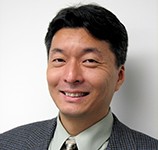
During the XIV SBPMat Meeting, Professor Ichiro Takeuchi will give a plenary talk on the combinatorial approach to materials discovery – an issue that is part of his daily life. Takeuchi is a Professor of the Materials Science and Engineering Department at the University of Maryland, in the United States, since 1999. In this institution, he leads the Combinatorial Synthesis and Rapid Characterization Center and the Keck Lab for Combinatorial Nanosynthesis/ Multiscale Characterization. He is a Visiting Professor at the Tokyo University of Science since 2010. He is also member of the Executive Committee of the Forum on Industrial & Applied Physics from the American Physical Society (APS).
Takeuchi graduated with a Degree in Physics in 1987 at the California Institute of Technology (Caltech). For four years he worked in Japan at the microelectronics research laboratories of the NEC Corporation, to later return to the United States. In 1996, he earned his Ph.D. at the University of Maryland. Then, he went to the Lawrence Berkeley National Laboratory, where he stayed until 1999 as a postdoctoral researcher. In 2004, he was the chairman of the Gordon Conference on Combinatorial and High-throughput Materials Science. In 2009, he founded a company dedicated to the development of materials and systems for applications in the field of energy, the Maryland Energy and Sensor Technologies, LLC.
Ichiro Takeuchi was a Visiting Professor at universities in Japan and Germany. He has received awards and distinctions from the National Science Foundation (Career Award), the Office of Naval Research in the US (Young Investigator Program Award) and the University of Maryland, among other institutions. The scientist, whose H index is 40, according to Google Scholar, is the author of over 180 papers, with more than 5,900 citations, and a book on the combinatorial synthesis of materials.
What follows is a brief interview with this plenary speaker.
SBPMat newsletter: – Help us to visualize how the combinatorial research is performed. For instance, choose an example of a material created in your laboratories with this approach, and outline the “step-by-step”.
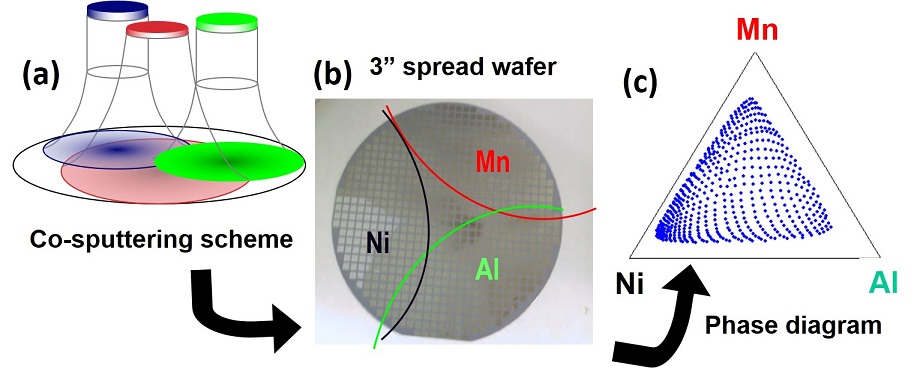
Ichiro Takeuchi: – We do thin film based combinatorial materials research. The goal is to carry out rapid screening of previously unexplored compositional landscape in order to discover new materials with enhanced physical properties. We make wafers or chips where there are large composition variations in deposited thin films. Sometimes the thin films are separated into different pads, and sometimes it is one continuous film with changing composition across the wafer. We want the variation to be as large and diverse as possible, so that we can map large compositional variation in a single experiment. We then take different characterization techniques to carry out rapid screening of various physical properties. For example, right now, we have a project to search for new permanent magnet materials. For this, we use techniques such as scanning SQUID or scanning magneto-optical Kerr effect measurements. These measurements can be used to map magnetic properties of all the compositions on a single wafer. These wafers and chips are called combinatorial libraries. We also do a lot of structural characterization. For this purpose, we often go to synchrotron beamlines. At such locations, because of the large beam flux, we are able to carry out x-ray diffraction of the entire wafer very quickly. Right now, we can scan 200-300 spots in 2 hours.
SBPMat newsletter: – In your opinion, what are your most significant contributions in the field of combinatorial materials science? Please explain them, very briefly, and share references from the resulting articles or books, or comment if these studies have produced patents, products, spin-off companies etc.
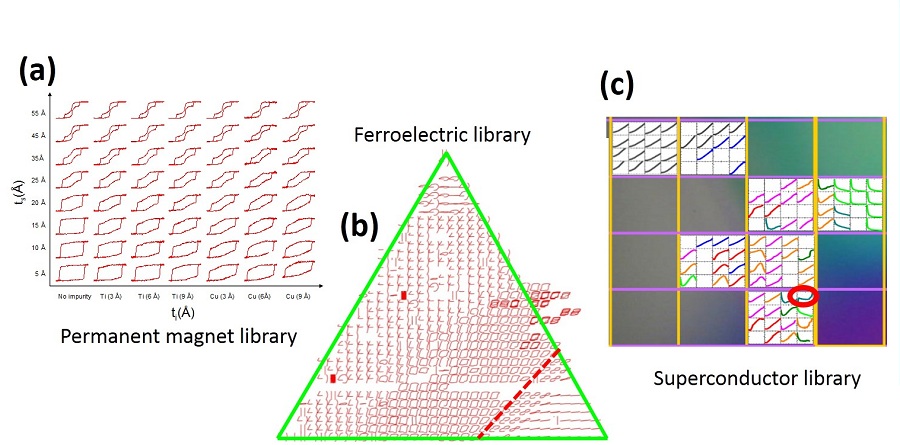
Ichiro Takeuchi: – Over the years, we have carried out combinatorial investigation on a variety of topics in the general field of functional materials. They include superconductors, shape memory alloys, magnetosrictive materials, ferroelectric and dielectric materials to name a few. In carrying out such experiments, we have had to develop and establish techniques to effectively implement the strategies. We have indeed discovered a number of new compounds. For instance, working together with theoretical colleagues, we have found shape memory alloys with long fatigue lives. I have patents on a number of low-loss dielectric materials as well as novel piezoelectric materials. Many groups are now doing follow-on work on a lead-free morphotropic phase boundary piezoelectric material we found a number of years ago. In addition to the materials that were discovered, we have established combinatorial strategies as a technique to rapidly delineate composition-structure-property relationships in different materials systems. We have recently published a comprehensive review article. It is: “Applications of high throughput (combinatorial) methodologies to electronic, magnetic, optical, and energy-related materials,” Journal of Applied Physiscs 113, 231101 (2013) by Martin L. Green, Ichiro Takeuchi, and Jason R. Hattrick-Simpers.
SBPMat newsletter: -If you wish, leave a message or an invitation to your plenary talk to the readers who will attend the XIV SBPMat Meeting.
Ichiro Takeuchi: – The notion of search and discover is central to materials research. The combinatorial methodology is the natural counterpart to the concerted efforts in theoretical design of materials taking place around the world. By effectively coupling theory with high-throughput experimentation, we can really accelerate the rate at which new materials are discovered. I will present a mode of research we call “integrated materials engine” where theory and experiments are woven together and built on a flexible database and data management platform.
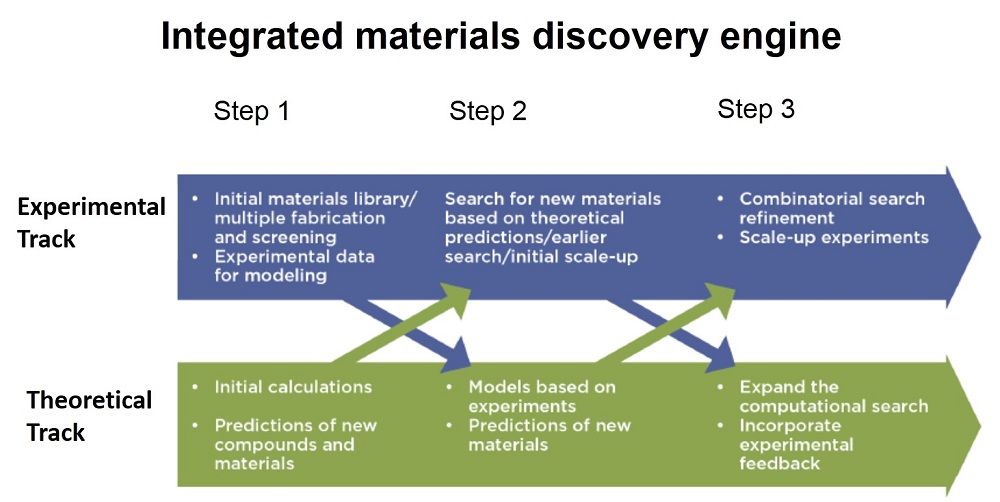
More: